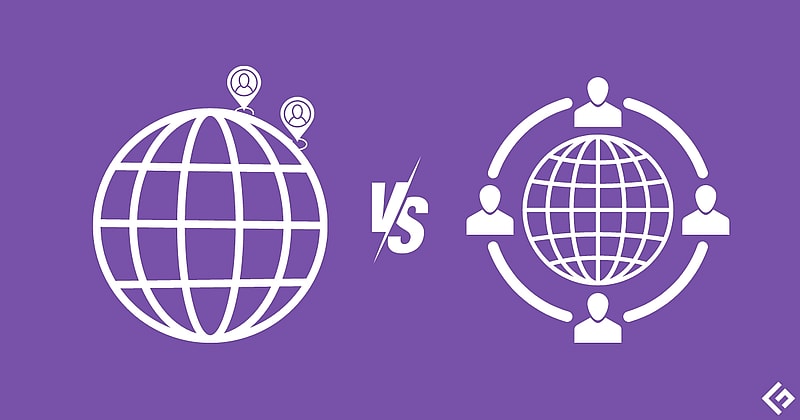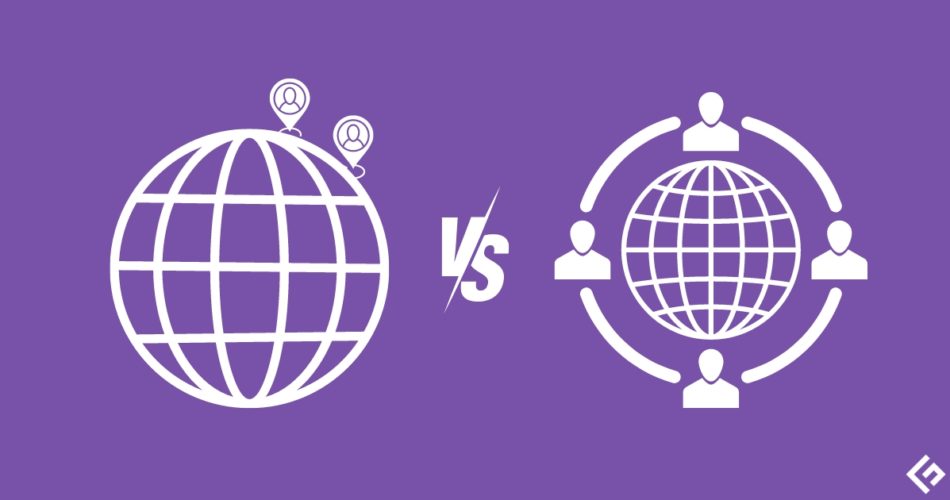
Nearshore and offshore outsourcing are strategies used by businesses to delegate tasks or projects outside their premises or country to reduce costs and access a wider talent pool.
In nearshoring, a company hires a third-party service provider or agency in a nearby country or region for easier communication and collaboration.
In offshoring, companies hire a third-party service provider or agency in a low-cost country to reduce costs. However, this approach introduces challenges such as language barriers, cultural differences, and time zone discrepancies.
Nearshore and offshore outsourcing have gained popularity among businesses due to the numerous benefits they provide. The global business process outsourcing industry is projected to grow at a 9.4% CAGR, reaching an estimated $525.2 billion by 2030.
When deciding between nearshore and offshore outsourcing, it is important to consider factors such as communication, time zone differences, and cultural alignment, as these can impact the success of outsourcing projects for your business. Both options offer cost-effective solutions and access to skilled professionals.
This article will explore the comparison between offsource and nearshore outsourcing and discuss the key factors, benefits, and challenges to consider when selecting between nearshore and offshore outsourcing to help you determine the best fit for your business.
What Is Nearshore Outsourcing?
Nearshore outsourcing is when a business or an organization outsources or delegates tasks to a team, agency, or freelancer in a nearby country or region that shares the same time zone or border with the organization. For example, a US organization could outsource tasks to an agency in Canada.

Nearshore outsourcing is a cost-effective way for businesses to hire experts and creatives across borders without hiring an in-house team—especially beneficial for businesses located in regions with higher labor costs.
Nearshore outsourcing is a great option for businesses that require regular collaboration and quick turnaround times.
What Is Offshore Outsourcing?
Offshore outsourcing is when a business or a company hires an agency, freelancer, or team located in a distant or faraway country with a significant time zone difference. An example of offshore outsourcing would be a company situated in the United States outsourcing specific work to a freelancer located in India or Australia.

Offshore outsourcing is a good option for cost savings and accessing a larger pool of skilled talent, especially in technical or specialized fields, despite potential communication and time zone challenges.
The location is the key distinguishing factor between nearshore and offshore outsourcing, but other factors also impact a project manager’s decision. Let’s examine the comparison between offshore and nearshore outsourcing in more detail.
Nearshore vs Offshore Outsourcing: A Detailed Comparison
| Differentiating Factors | Nearshore Outsourcing | Offshore Outsourcing |
|---|---|---|
| Time zone difference | Minimal time zone difference | Significant time zone difference |
| Real-time collaboration | Better real-time collaboration due to closer time zones and geographical proximity. | Challenges in seamless interaction and collaboration due to the time zone difference. |
| Geographic proximity | Nearby country | Distant country |
| Cultural affinity | Similar cultural norms and business practices—aligning with the company and the hired clients. | Vastly different cultural norms, styles, and practices—make it challenging to address cultural and language barriers. |
| Travel accessibility | The closer geographical proximity and time zone alignment make travel easy and less complicated. | Longer travel distances and more complex visa requirements can result in increased travel costs and logistical hurdles. |
| Language alignment | Similar language alignment. | Significant language barriers. |
| Project overall costs | Offers cost-effective solutions with comparable cost of living, although it may not be as cost-efficient as offshore outsourcing. | Offers high-cost savings and substantial cost reductions. |
| Best suited for | Best suited for projects requiring frequent communication, collaboration, and cultural alignment, such as those involving complex requirements or close client interaction. | Best suited for projects where cost savings are a primary concern and physical proximity or cultural alignment is less critical, such as large-scale development projects with well-defined requirements. |
Benefits of Nearshore Outsourcing
Here are the core reasons that make nearshore outsourcing beneficial and less of a hassle for businesses:
Facilitates real-time collaboration with time zone alignment
Effective communication and strong real-time team collaboration form the base of a successful project or a company. Nearshore outsourcing enables companies to connect with their clients or vendors to clarify things, resolve issues, and monitor the progress to enhance team agility with shorter feedback loops and iteration.
The time zone alignment makes it easier for companies to travel to the vendor location if needed, enables quick responses, and synchronizes efforts in real time for maximum productivity.
Cultural compatibility
Cultural compatibility is important in outsourcing business relationships. According to research by Accenture, 19% of organizations claimed that cultural barriers were the reason behind hesitance towards expanding their outsourcing model. Nearshore outsourcing allows companies and their vendors to share similar cultural and business practices, work ethics, and values—avoiding risks of misunderstandings and miscommunication.
Easier to control partners with audits
Nearshore outsourcing simplifies audits as the companies can easily travel to the vendor location for monitoring and take better control of the intellectual property. Moreover, both entities are more likely to share similar data protection laws, eliminating compliance and regulatory risks and misunderstandings when signing the contract.
Benefits of Offshore Outsourcing

Here are the benefits of offshore outsourcing for businesses looking to manage their work with deadlines at budget.
Cost-efficiency
One of the biggest benefits of offshore outsourcing is cost-efficiency, allowing companies to save on labor costs. Due to the economic differences between the two countries, especially between a developed and developing country, companies can save a lot of money than outsourcing the work to nearby country clients.
Access an unlimited pool of talent
Offshore outsourcing allows companies to access a larger pool of talent with niche expertise and skills, providing the opportunity to find the best fit for their specific work needs.
Unique expertise and technological benefits
Offshore outsourcing allows companies to hire experts from countries with better technological advancements and unique expertise in specific areas like domains and tech, marketing, or finance.
Challenges of Nearshore Outsourcing
While nearshore outsourcing provides potential benefits, it comes with its own set of risks, as mentioned below:
Highly expensive
Nearshore outsourcing is more expensive than offshore outsourcing due to the higher cost of living and labor. Companies can overcome this challenge by researching multiple locations and choose the most cost-effective region-based vendor/agency.
Limited pool of expert candidates
Finding the right talent and expertise can be challenging when searching for vendors in nearby countries. To overcome this challenge, companies can offer training to hired vendors or partner with firms that prioritize continuous training and skill development to ensure the right expertise for their projects.
Economic and political concerns
Nearshore outsourcing poses potential risks, such as political instability, economic uncertainties, and regulatory changes, which may lead to uncertainties and challenges. To address this challenge, companies should perform a thorough risk assessment of nearshore vendors, establish contingency plans for political disruptions, and select locations with stable political and economic environments to minimize risks and ensure compliance.
Challenges of Offshore Outsourcing
Cultural differences
Companies often avoid offshore outsourcing because of the challenges presented by cultural differences with other countries. To address these differences, companies can offer cultural training and employ cultural liaisons. It is important to respect the client’s cultural beliefs and practices and be open to adapting to their work culture for effective collaboration.
Limited monitoring and control
Working with an offshore vendor can make it challenging for companies to monitor and control project progress. This can lead to issues in providing detailed feedback, affecting quality and productivity. To help with this, companies can invest in project management tools for assigning tasks, tracking progress, and ensuring transparency. It is important to establish clear expectations, maintain regular communication, and conduct periodic audits to evaluate performance and identify areas for improvement.
Time zone differences
Time zone differences make traveling offshore locations and real-time collaboration quite a hassle, leading to potential issues like missed deadlines. Employing strategies such as overlapping working hours, utilizing asynchronous communication tools like email and project management tools, and establishing short-term goals and regular meetings can help mitigate these issues and maintain effective communication between the company and offshore vendors.
Factors To Consider When Choosing Outsourcing

Choosing the right type of outsourcing solution is paramount for businesses to achieve successful project management.
Here are a few essential features you must consider when deciding between nearshore and offshore outsourcing.
#1. Identify your project and skills requirement
When choosing an outsourcing partner, it’s important to consider their specific skills, technological expertise, and industry experience to ensure they meet your project requirements. For example, if you need a skilled Java developer for a project with a tight deadline, looking for an outsourcing partner in Poland known for having the most skilled Java developers in the world may be the best choice.
#2. Conduct thorough research and explore potential options
Once you choose the specific location or country, the next step is to choose the right agency or vendor that meets your business needs. Make a list of top agencies or experts in the industry and research their experience, industries they’ve worked with, culture, reputation, case studies, portfolios, and customer reviews. This will help you choose a vendor or agency that aligns with the project’s scope and requirements.
#3. Identify your budget constraints
Most companies consider budget as one of the most prominent determining factors when deciding upon an outsourcing partner. While offshore outsourcing is more cost-effective, nearshore outsourcing can offer more value in the long run. Thus, it’s important to clearly communicate your budget constraints and the project cost to avoid any misunderstandings and choose a vendor that offers the expected value and aligns with your company’s financial structure.
#4. Look into cultural compatibility
Cultural alignment and efficient communication can play a major role in the project’s success. This impacts how well your company and its employees collaborate and communicate with the vendor’s team.
Thus, it’s crucial to evaluate if the vendor or service provider has experience working with companies in your region or country and also analyze their cultural sensitivity, language proficiency, and willingness and ability to adjust to your workplace culture.
#5. Evaluate security measures
Security is paramount for any outsourcing model. Before partnering with any outsourcing vendor, it’s crucial to evaluate the company’s security measures, history of security and cybersecurity attacks, and compliance and regulation measures to avoid security risks in the long run.
Best Practices For Managing Outsourced Projects

Here are a few best practices to manage an outsourced project effectively.
Define clear project goals, scope, and schedule
Vendors and service providers require as much information and details about the project as possible, including expectations, quotes, delivery, etc., to avoid scope creep. Clearly defining the project’s objectives, timelines, and budget helps establish a mutual understanding of the desired outcome.
Build trusting relationships with the stakeholders
Building strong work ties and trusting relationships with your vendors can go a long way in building long-term and quality relationships within the industry. It’s crucial to communicate issues or misses with the vendors, send detailed invoices, and make them feel a part of your company—by providing a sense of ownership over the project.
Establish a detailed agreement or contract
Documenting all terms and conditions in a comprehensive agreement, including the project scope, payment terms, milestones, confidentiality clauses, intellectual rights, and dispute resolution solutions, is crucial to ensure long-term and seamless project management.
Maintain open and regular communication
Good teamwork comes with establishing regular communication channels, frequent sprint reviews, addressing challenges, and more using project management tools or channels, like email, video calls, or in-person meetings.
Designate and clarify roles and responsibilities
To promote accountability and responsibility, it is essential to assign clear responsibilities to the vendor team and your company’s team, including the managers, team members, and decision-makers.
Manage risks proactively
Anything can go wrong at any time, including missed deadlines, resources going backfoot, cultural discrepancies, or changes in the project requirements. Companies must evaluate the possibilities of these risks, understand the responsible stakeholders, and come up with mitigation plans to avoid risk escalation.
Monitor performance and encourage feedback and transparency
Regularly monitor work quality against predetermined benchmarks, address any deviations, and provide constructive feedback to promote a culture of transparency and strong work ethics.
Avoid team burnout
Assigning realistic tasks and scheduling achievable deadlines is essential for maintaining a healthy relationship with your outsourcing client. Overloading them with tasks can lead to decreased productivity and the potential loss of the outsourcing partner. Using tools like Asana can assist in creating a manageable workload for your vendor and preventing burnout.
Thus, an outsourcing journey doesn’t just stop at choosing and partnering with the right outsourcing partner. Managing the outsourcing project and team plays an equally crucial role when looking for long-term collaboration.
FAQs
What is an example of nearshore outsourcing?
An example of nearshore outsourcing is when a company based in the United States outsources work or projects to a vendor in Canada or Mexico. For instance, Slack, headquartered in California, outsources certain services and branding elements development to companies in Canada.
What is an example of offshore outsourcing?
An example of offshore outsourcing is when a company based in the United States outsources a project to a vendor based in India or Australia. Taking Slack as an example again, it outsources most of its design and development tasks to the Philippines—using an offshore outsourcing model.
Choosing Between Nearshore and Offshore Outsourcing
Nearshore and offshore outsourcing serve different purposes for companies based on their specific needs. Nearshore outsourcing offers advantages such as easier travel and management logistics and avoids cultural and language barriers, while offshore outsourcing is often chosen for its cost-effectiveness.
While selecting the right outsourcing partner is essential, managing the relationship is key for long-term success and collaboration.
Thus, make sure you follow the best outsourcing management practices mentioned above, evaluate your business needs and project requirements, and conduct proper research to choose the best outsourcing model for your company.



